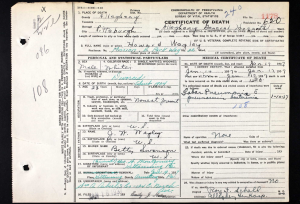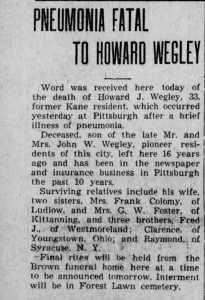April 26, 1903 – January 17, 1937
Howard J. Wegley, born on April 26, 1903, in the small town of Kane, Pennsylvania, lived a life reflecting the challenges and complexities of early 20th-century America.
Despite his relatively brief 33 years, his story intertwines moments of personal struggle, societal pressure, and resilience. He passed away on January 17, 1937, due to pneumonia, leaving behind a legacy that captures the trials of his era.
Early Life and Family
Howard grew up in Kane, Pennsylvania, within a close-knit family. As an adult, he married Olive Rush Hooks, and together, they had one son, Leroy G. Wegley, born on September 16, 1930.
However, Howard’s marriage encountered challenges, and records surrounding his marital status at the time of his death reveal inconsistencies. While his obituary stated that he was survived by his wife, his death certificate listed him as divorced. Olive later remarried in 1948 to William Macaluso, suggesting that their separation was finalized at some point before Howard’s death.
Later Years and Legal Troubles
Howard’s life took a difficult turn when, on March 11, 1935, he was sentenced to the Allegheny County Workhouse and registered as Prisoner #39227. This institution, located near Blawnox, Pennsylvania, served as both a workhouse and an inebriate asylum, providing labor and rehabilitation for minor offenders. Inmates worked on extensive farmlands, tending crops and livestock as part of their sentences.
Howard’s prison records provide a physical description of him at the time: he stood 5’7″ tall and weighed 113 pounds upon entry, gaining nearly 10 pounds by the time of his release. Unfortunately, the exact crime for which he was convicted remains unclear, as the handwritten record is illegible. Context from the prison’s population suggests it may have been a minor offense, common for inmates housed there.
I’m not quite sure what crime he was convicted of. It’s listed (see image below), but I can’t read what the word is.
Maybe you’ll have better luck. I’ve included his crime listed below, next to the others, to give you some sort of context.
Final Days
Howard’s health began to deteriorate in early 1937. On January 10, he first reported symptoms of what would later be diagnosed as pneumonia. He was admitted to Allegheny General Hospital on January 14, but despite medical intervention, he passed away just three days later, in the early hours of January 17. His obituary, published in The Kane Republican on January 18, 1937, detailed his untimely death and noted that he had resided at 22 Mission East Parkway, Pittsburgh, Pennsylvania.
Legacy
Howard J. Wegley’s story is a reflection of the societal norms, struggles, and personal challenges of his time. His journey—marked by love, loss, and perseverance—offers a glimpse into the fabric of early 20th-century American life. Through his son, Leroy, and the memories of those who knew him, Howard’s life continues to be a poignant part of his family’s history.
Share this:
- Click to email a link to a friend (Opens in new window) Email
- Click to print (Opens in new window) Print
- Click to share on Facebook (Opens in new window) Facebook
- Click to share on X (Opens in new window) X
- Click to share on Reddit (Opens in new window) Reddit
- Click to share on LinkedIn (Opens in new window) LinkedIn
- Click to share on Telegram (Opens in new window) Telegram
- Click to share on Threads (Opens in new window) Threads
- Click to share on WhatsApp (Opens in new window) WhatsApp
- Click to share on Bluesky (Opens in new window) Bluesky



You must be logged in to post a comment.